9. Scent of the South.
Delacroix in Algeria, Gauguin in Tahiti: this is a class about French artists influenced by cultures to the south of them, or in
a different continent entirely. But it is also about how what we imagine about a distant place and what we actually find when we
go there are two quite different things.
Why these differences? Perhaps because the place we want to see is inaccessible to us on account of our sex or culture, as is the
case with Western contact with the Islamic world. Perhaps because it is too far away to allow for easy travel, as used to be the
case with India. Perhaps because the sounds, colors, and rhythms that attract us are only a part of a more humdrum whole, as is
the case with the French experience of Spain. Perhaps because the corrupting aspects of the everyday world got there before we did,
as with Gauguin in Tahiti. Or perhaps because we imagine other places, other paradises, that we half know will never exist in
reality. rb.
The script, videos, and images will be posted immediately after class.
Here are brief bios of the artists, composers, and writers considered in the class, listed in order of birth.
 |
Wolfgang Amadeus Mozart, 1756–91. Austrian composer.
A child prodigy as both performer and composer, Mozart produced an extraordinary body of work in all genres over a relatively short life. He wrote the greatest of his many operas after moving to Vienna: three collaborations with Lorenzo da Ponte—The Marriage of Figaro (1786), Don Giovanni (1787), and Così fan tutte (1790)—framed by two German Singspiels: The Abduction from the Seraglio (1782) and The Magic Flute (1791).
|
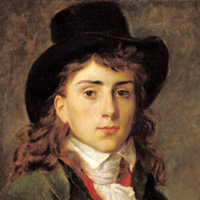 |
Antoine-Jean Baron Gros, 1771–1835. French painter.
After studying with David in Paris, Gros moved to Italy. His 1796 painting of Napoleon at Arcole, done while he was there, won him the patronage of the future Emperor, and he traveled with him in many of his subsequent campaigns, besides establishing himself as a portraitist back in Paris. He was ennobled in 1824.
|
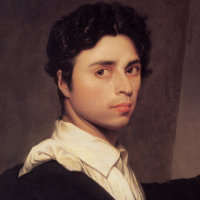 |
Jean-Dominique Ingres, 1780–1867. French painter.
Ingres was trained in the academic tradition, and indeed spent 7 years as Director of the French Academy in Rome. Although one of the great masters of French Romantic era, his style was always marked by a cool classicism and precision of line, in contrast to the freer handling of paint by his contemporary Delacroix.
|
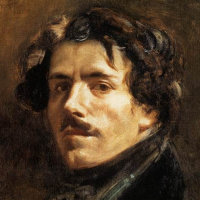 |
Eugène Delacroix, 1798–1863. French painter.
The leading French painter of the Romantic movement, he is known for his brilliant Rubensian color and his dramatic compositions. Especially in the first half of his career, these included political themes, such as The Massacre at Chios (1824) and Liberty Leading the People (1830), as well as subjects from Romantic literature. He also visited North Africa, and was constantly fascinated by the exotic.
|
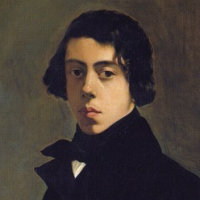 |
Théodore Chassériau, 1819–56. French painter.
Chassériau managed to combine the styles of his teacher Ingres with that of the leading Romantic painter of his time, Delacroix, in a variety of subjects taken from history and mythology.
|
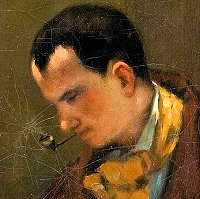 |
Charles Baudelaire, 1821–67. French poet.
Baudelaire is credited with coining the term "modernism," and is held to be the first modernist poet. His masterpiece, the Les fleurs du mal (The Flowers of Evil), which hovers between sensual verse and an exotic kind of prose, was prosecuted as an offence to public morals, and the author was fined. Baudelaire was nonethless a great influence on the next generation of poets, like Verlaine, Rimbaud, and Mallarmé.
|
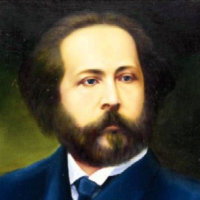 |
Édouard Lalo, 1823–92. French composer.
Lalo supported his composing by a career as a violinist and chamber musician. His Symphonie Espagnole (1875), a violin concerto in all but name, remains his most celebrated work, although you still hear individual numbers from his 1888 opera Le Roi d'Ys.
|
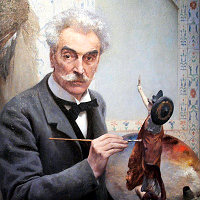 |
Jean-Léon Gérôme, 1824–1904. French painter.
A leading academic painter of the mid-century, his works have been described by one critic (Lorenz Eitner) as "carefully plotted picture-plays, graced with sex, spiced with gore, and polished into waxwork lifelikeness by a technique that his admirers took for realism."
|
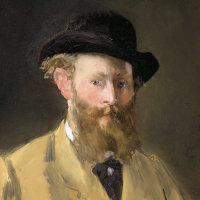 |
Édouard Manet, 1832–83. French painter.
Manet is arguably the greatest French painter in the third quarter of the 19th century. Though primarily a realist, he was influenced by older artists such as Titian and Velasquez. He was admired by the young Impressionists, became friends with Monet, and produced a number of works in their style, but he never exhibited with them, preferring to retain his own status in the official Salons.
|
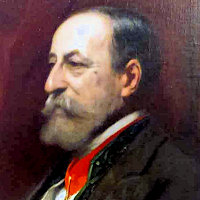 |
Camille Saint-Saëns, 1835–1921. French composer.
A pianist himself, Saint-Saëns wrote five concertos that remain in the repertoire. His most famous works are probably his Organ Symphony and Carnival of the Animals (both 1886), plus the opera Samson and Delila(1877). His Phaeton of 1873 tells the story as a 10-minute symphonic poem.
|
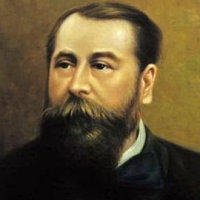 |
Léo Delibes, 1836–91. French painter.
Delibes is best knows for his ballets Coppélia (1870) and Sylvia (1876), which are part of the standard repertoire. Although he wrote several lighter piece, his only opera that is occasionally performed is Lakmé (1883)
|
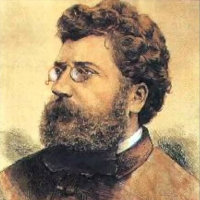 |
Georges Bizet, 1838–75. French composer.
Bizet's fame rests largely on his final opera, Carmen (1875), although it was not a success at its first performance. Its immense poshumous success has led to reconsideration of many of the composer's earlier works, such as his youthful Symphony in C (1855) and opera The Pearl Fishers (1863).
|
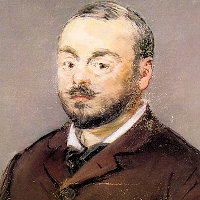 |
Emmanuel Chabrier, 1841–94. French composer.
Largely self-taught as a composer, he worked in the civil service until 1880. He wrote several operas, including L'étoile in 1877, but is best remembered for his orchestral pieces España (1883) and Marche joyeuse (1888).
|
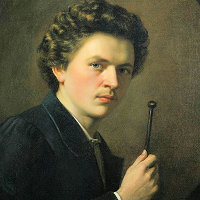 |
Henri Regnault, 1843–71. French painter.
A winner of the Prix de Rome, Regnault produced works in a romanticized acadmic style, together with Orientalist subjects such as his Salomé in the Met and Summary Execution at the Orsay (both 1870). He was killed fighting in the Franco-Prussian War.
|
 |
Paul Gauguin, 1848–1930. French painter, sculptor, and ceramicist.
Influenced at first by the Impressionists, Gauguin soon abandoned that style for one that involved large flat areas of pure color. He is associated with three areas: Brittany, where he developed his style; Provence, where he lived with Van Gogh; and Tahiti, perhaps indulging a taste for the tropics inherited from his Peruvian mother. He is considered one of the giants of the Post-Impressionist period.
|
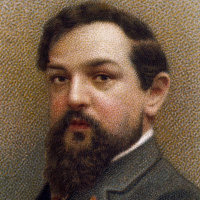 |
Claude Debussy, 1862–1918. French composer.
Debussy was one of the most original French composers of the 20th century and, with Ravel, the prime exponent of what is commonly called Impressionism, the creation of musical images through harmony, texture, and scraps of melody. Although an exquisite orchestrator, his most original works are probably those written originally for piano, including two books of Préludes from the last years of his life.
|
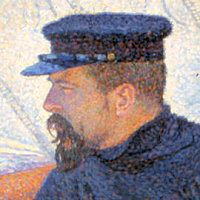 |
Paul Signac, 1863–1935. French painter.
Signac met Georges Seurat when he was 21, and devoted the rest of his career to developing his pointillist style. He was the first of many turn-of-the-century painters to explore the visual potential of the South of France. By temperament a philanthropist and social reformer, he used his independent means to help many of his contemporay artists, being the first for example to buy the work of Matisse.
|
 |
Henri Matisse, 1869–1954. French painter and sculptor.
Matisse and Picasso stand as the giant pillars of French art in the first half of the 20th century. Matisse was the slower starter and the less versatile, but he stands alone for the richness of his color and the sensuality of his forms, whether in painting or in sculpture. Suffering from crippling arthritis at the end of his life, he produced a completely new oeuvre in colored-paper collage.
|
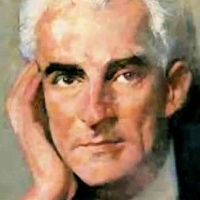 |
Maurice Ravel, 1875–1937. French composer.
Though often grouped with Debussy as a musical Impressionist, Ravel was very much his own man. As a composer with a strong sense of tradition, he often wrote in older dance forms. As a virtuoso pianist, he wrote piano music of transcendent difficulty that extended the range of piano techniques. And as a master orchestrator, he enriched 20th-century music with some of its most vibrant colors.
|
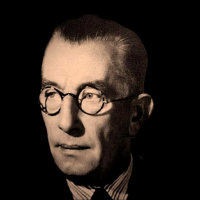 |
Maurice Delage, 1879–1961. French composer.
Delage was a pupil of Ravel, who thought very highly of him. As a young man, he traveled with his businessman father to Japan and India, the latter giving him material for his best-known work, Four Hindu Poems (1912).
|
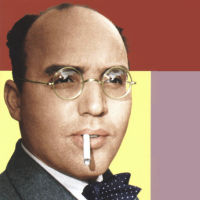 |
Kurt Weill, 1900–50. German American composer.
Weill became famous in Berlin for his collaborations with Bertolt Brecht, among them The Threepenny Opera (1928, a satirical adaptation of John Gay's The Beggar's Opera,) and the political opera The Rise and Fall of the City of Mahagonny (1930). Fleeing Nazi Germany, he eventually settled in New York in 1935, finding new fame on Broadway, but also writing more operatic fare such as Street Scene (1946, with Langston Hughes).
|
 |
Léo Ferré, 1916–93. French songwriter.
Born in Monte Carlo, where his father was manager of the casino, and encouraged by Edith Piaf, Ferré became one of the leading singer-songwriters in France after WW2, performing both his own material and songs he composed to other texts, such as Baudelaire's Fleurs du mal.
|
 |
Maurice Béjart, 1927–2007. Franco-Swiss choreographer.
Although Béjart created many large expressionist works with grand themes, he is probably best known for his version of Ravel's Boléro, created for the Yugoslav ballerina Duška Sifnios, but since danced by many other female stars.
|
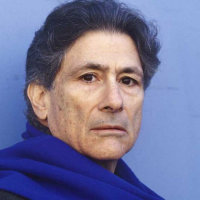 |
Edward Wadie Saïd, 1935–2003. Palestinian-American writer.
Saïd was born in Jeusalem, but had American citizenship through his father, who had served in the US Army. He studied at Princeton and Harvard and later became a professor at Columbia. His controversial 1978 book Orientalism became a required text in Post-Colonial Studies, a field that Saïd founded. He was a lifelong activist, not merely for Palestinian causes but for better understanding between peoples, for example by founding (with Daniel Barenboim) the West-Eastern Divan Orchestra, composed of young Israeli, Palestinian, and Arab musicians.
|

























































